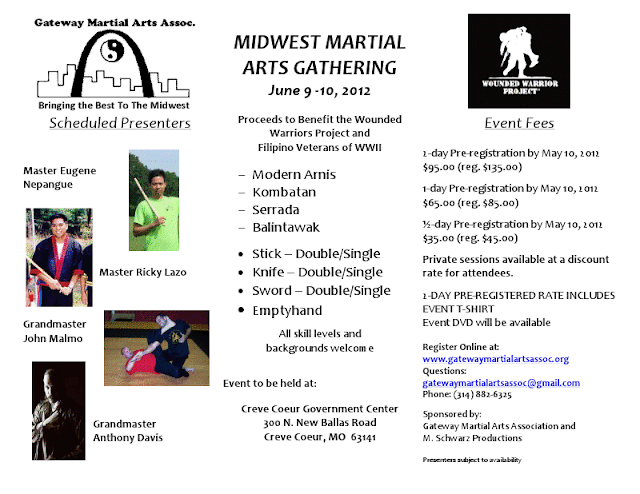The SE Asian Martial Arts blog is an open discussion venue dedicated to the exchange of information involving the South East Asian Martial Arts such as Escrima, Arnis, Pentjak Silat and Kuntao Silat in particular as well as other Asian martial arts in general. Our goal is to give our blog writers and readers a forum that encourages our members to share information, techniques, seminars dates and training camp dates.
Tuesday, February 28, 2012
Sunday, February 5, 2012
The Conceptual Framework of FMA Practice
Many times have I heard teachers in my martial art training experience mention triangles, circles, and squares. One such example involved three sides of a "learning" triangle representing fighting skill, technical skill, and drill/play. You see this diagram, if you would imagine it, said something about the way one might learn to fight or develop skill in surviving violence.
As the story had it, one could theoretically learn just by fighting a bunch, but at a cost. Then there could be learning through drilling--hopefully correct responses--repetitively. The emotional factor may get lost if application isn't obvious enough to excite the participant to keep repeating or applying such an awesome or important maneuver; otherwise good repetitions are required and worth the cost if we are to use such skills for survival lets say... Knowing that motivates me to work on some of the same stuff time and time again. The technical aspect deserves its attention too, and putting it into play, functional drills, and sparring allows for authentic assessment of said skills. That brings me to play which is well known for its ability to promote growth in children and those who engage in it. Now I don't think that play by itself could lead to much discovery in combat, but when combined these three elements offer a way to combine and cover material and possibly apply functional tactics and techniques too. So play with an objective can be productive, and the limits are endless as are the opportunity for exploring, discovering, applying, synthesizing, comprehending, etc.
Depending on your objective, activities may vary but a few learning methods I have used are training alone, alone and with an object or two, with a partner and no object, a partner and an object we share, a partner and an identical object we each have, mirroring, shadowing, or mimicking are also primary ways of learning countless techniques or reviewing movements. Patterns are things are brain naturally picks up on, a naming allows us to identify and describe laws at work when we do what we do. A well rounded practice with a degree of directness and simplicity along with real life effectiveness is what I strive for, and model from others. So many have shared techniques, and others drills, and each the spirit behind the art, and science of Eskrima, Modern Arnis, Kali, KunTao. So many guides pointing us towards such good stuff that is just waiting for us to put in the time and gain the experience...Thank You to them and all of you for following this topic. I hope we can keep bringing these arts full circle as we broaden our triangles!
As the story had it, one could theoretically learn just by fighting a bunch, but at a cost. Then there could be learning through drilling--hopefully correct responses--repetitively. The emotional factor may get lost if application isn't obvious enough to excite the participant to keep repeating or applying such an awesome or important maneuver; otherwise good repetitions are required and worth the cost if we are to use such skills for survival lets say... Knowing that motivates me to work on some of the same stuff time and time again. The technical aspect deserves its attention too, and putting it into play, functional drills, and sparring allows for authentic assessment of said skills. That brings me to play which is well known for its ability to promote growth in children and those who engage in it. Now I don't think that play by itself could lead to much discovery in combat, but when combined these three elements offer a way to combine and cover material and possibly apply functional tactics and techniques too. So play with an objective can be productive, and the limits are endless as are the opportunity for exploring, discovering, applying, synthesizing, comprehending, etc.
Depending on your objective, activities may vary but a few learning methods I have used are training alone, alone and with an object or two, with a partner and no object, a partner and an object we share, a partner and an identical object we each have, mirroring, shadowing, or mimicking are also primary ways of learning countless techniques or reviewing movements. Patterns are things are brain naturally picks up on, a naming allows us to identify and describe laws at work when we do what we do. A well rounded practice with a degree of directness and simplicity along with real life effectiveness is what I strive for, and model from others. So many have shared techniques, and others drills, and each the spirit behind the art, and science of Eskrima, Modern Arnis, Kali, KunTao. So many guides pointing us towards such good stuff that is just waiting for us to put in the time and gain the experience...Thank You to them and all of you for following this topic. I hope we can keep bringing these arts full circle as we broaden our triangles!
Subscribe to:
Posts (Atom)
